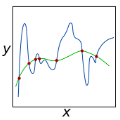Linear regression is a widely used technique to fit linear models and finds widespread applications across different areas such as machine learning and statistics. In most real-world scenarios, however, linear regression problems are often ill-posed or the underlying model suffers from overfitting, leading to erroneous or trivial solutions. This is often dealt with by adding extra constraints, known as regularization. In this paper, we use the frameworks of block-encoding and quantum singular value transformation (QSVT) to design the first quantum algorithms for quantum least squares with general $\ell_2$-regularization. These include regularized versions of quantum ordinary least squares, quantum weighted least squares, and quantum generalized least squares. Our quantum algorithms substantially improve upon prior results on quantum ridge regression (polynomial improvement in the condition number and an exponential improvement in accuracy), which is a particular case of our result. To this end, we assume approximate block-encodings of the underlying matrices as input and use robust QSVT algorithms for various linear algebra operations. In particular, we develop a variable-time quantum algorithm for matrix inversion using QSVT, where we use quantum eigenvalue discrimination as a subroutine instead of gapped phase estimation. This ensures that substantially fewer ancilla qubits are required for this procedure than prior results. Owing to the generality of the block-encoding framework, our algorithms are applicable to a variety of input models and can also be seen as improved and generalized versions of prior results on standard (non-regularized) quantum least squares algorithms.
翻译:量子正则化最小二乘
线性回归是一种广泛应用于拟合线性模型的技术,在机器学习和统计学等不同领域都有着广泛的应用。然而,在大多数实际场景中,线性回归问题往往是不适定的或潜在模型存在过拟合问题,导致出现错误或微不足道的解决方案。通常通过增加额外的约束条件,即正则化来处理这种问题。在本文中,我们利用块编码和量子奇异值变换(QSVT)框架来设计量子最小二乘的第一个量子算法,其具有一般 $\ell_2$ 正则化。这些包括量子普通最小二乘、量子加权最小二乘和量子广义最小二乘的正则版本。我们的量子算法大大改进了关于量子岭回归(条件数的多项式提高和精度的指数提高)的先前结果,这是我们结果的一个特例。为此 ,我们假设底层矩阵的近似块编码是输入,并使用各种线性代数操作的鲁棒QSVT算法。特别地,我们利用量子特征值区分作为子例程而非间隙相位估计,开发了一个变时间量子算法,用于使用 QSVT 进行矩阵反演。这确保所需的辅助量子比在先前结果中少许多。由于块编码框架的通用性,我们的算法适用于各种输入模型,并且也可以看作是先前结果在标准(非正则化)量子最小二乘算法方面的改进和推广版本。




